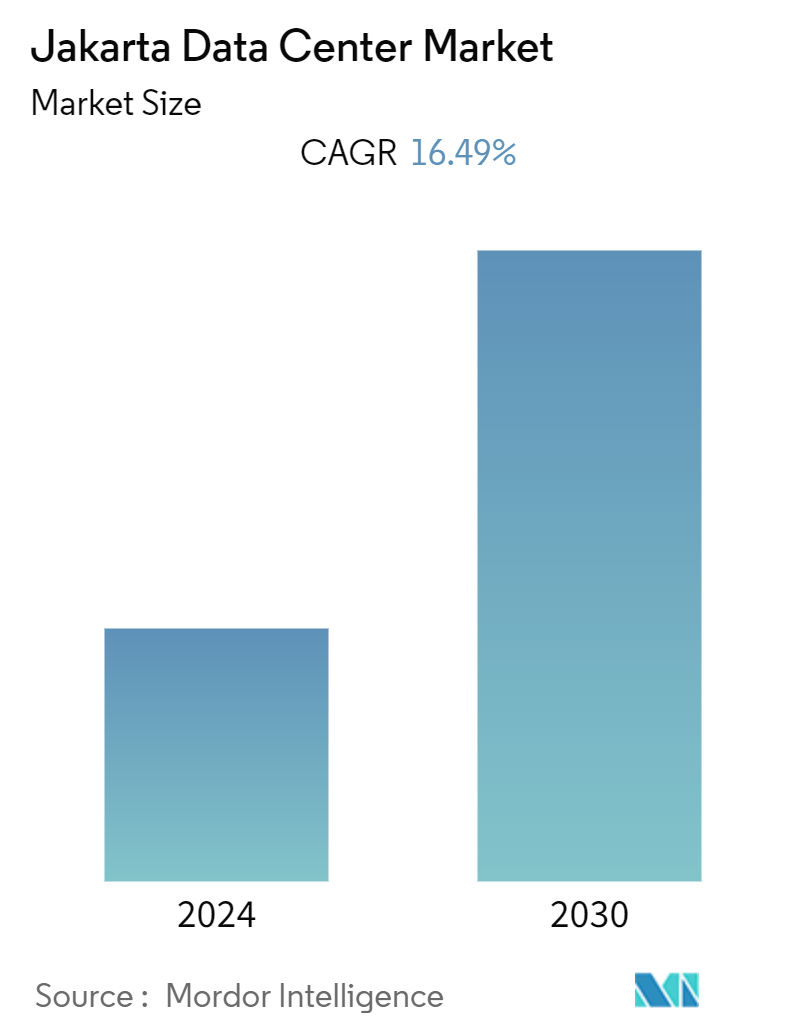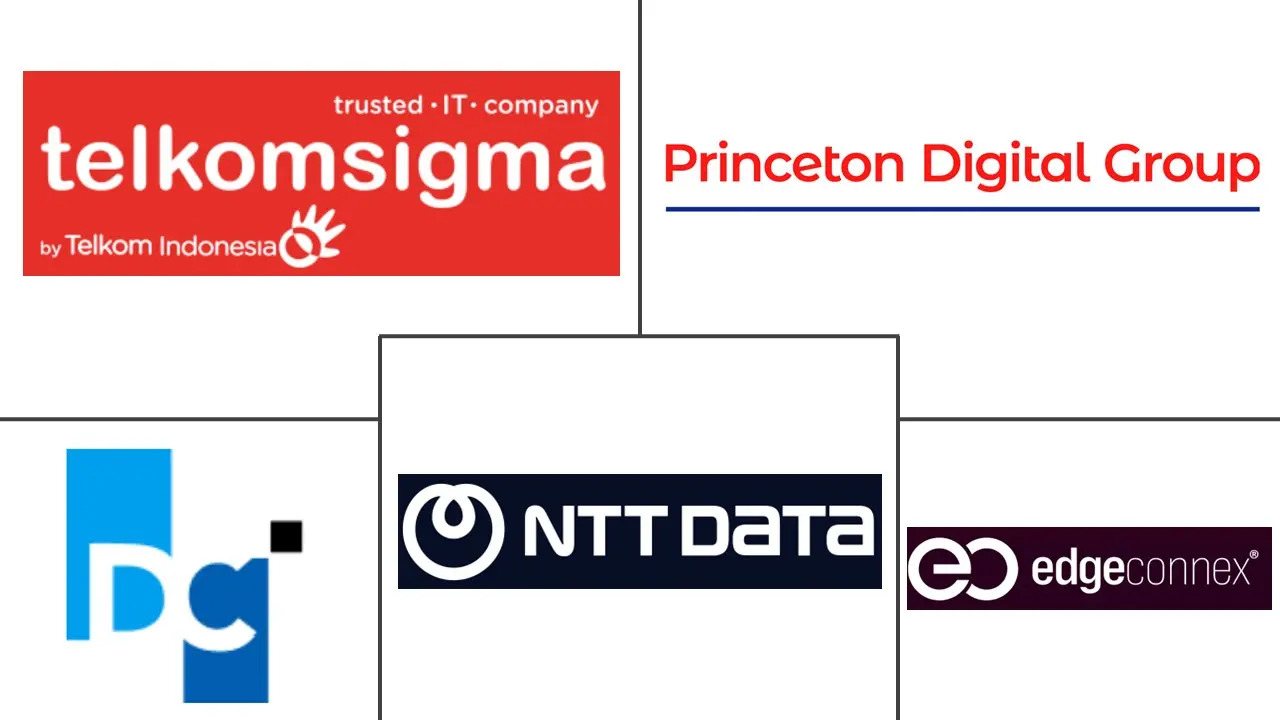| Study Period | 2019 - 2030 |
| Base Year For Estimation | 2023 |
| Forecast Data Period | 2024 - 2030 |
| Historical Data Period | 2019 - 2022 |
| CAGR | 16.49 % |
| Market Concentration | Medium |
Major Players*Disclaimer: Major Players sorted in no particular order |
Jakarta Data Center Market Analysis
The Jakarta Data Center Market is expected to register a CAGR of 16.49% during the forecast period.
The main drivers anticipated to drive the market expansion are the increasing demand for energy-efficient data centers, considerable investment by colocation service and managed service providers, and expanding hyperscale data center building. Additionally, the development of Big Data, cloud computing, and the Internet of Things (IoT) has made it possible for businesses to invest in new data centers to preserve business continuity.
- Additionally, industrial development is expected to prosper due to the rising need for security, operational efficiency, improved mobility, and bandwidth. Software-based data centers boost industry growth by providing a higher level of automation.
- There are various reasons for the growth of data centers in Jakarta. One of the primary reasons is the country's rapidly growing digital economy and the increasing adoption of cloud services and big data analytics by businesses in the region. With a population of over 270 million people and a fast-growing middle class, Jakarta has become an attractive market for international technology companies looking to expand their operations and establish a presence in Southeast Asia.
- Another significant factor driving the growth of data centers in Jakarta is the government's push to develop digital infrastructure and increase connectivity across the country. The government is investing heavily in expanding the country's internet and broadband infrastructure, which is making it easier for people to access online services and for businesses to deploy cloud-based applications and services.
- More than any other application, artificial intelligence (AI) with machine learning (ML) needs the construction of whole new data center architecture. AI and machine learning (ML) may require three times the power density of typical data processing, necessitating a data center architecture revolution. To sustain the higher output, specialized cooling systems are also required. Because of the intensive nature of AI and ML computations, there may be a large dispersion of computational, memory, and storage resources among multiple processors in a computing cluster.
- The government in the city is partnering with various AI service providers to deploy the capabilities of AI; this would push the construction of data centers in the region. For instance, in September 2022, the SAS Institute was strengthening its relationship with the Jakarta City Government by aiding with the city's Flood Control System. The JAKI platform predicts and monitors at-risk locations in real time using SAS Analytics for IoT to mitigate potential damage or harm and raise public awareness of crises.
- With these predictive powers and analysis, the Jakarta City Government can determine when to activate water pumps, accelerating disaster response and improving flood preparedness. The SAS solution uses AI and machine learning to quickly and accurately acquire and act on enormous volumes of data in real time, resulting in a shorter time or speed to take essential actions that limit or eliminate damage to life, property, and enterprises in the city.
- Moreover, development centers have undertaken a substantial study on energy efficiency in data centers, concentrating on optimal quality of service, effective resource utilization, and cost-cutting operations. They intend to reduce brown energy consumption by offering a load-balancing strategy that uses available green energy. Load balancing is based on renewable energy and has been used in several data centers. A workload and energy management plan was implemented to reduce network operational and energy costs. Combined cooling, heating, and power (CCHP) systems can also cut carbon emissions and air pollution while increasing resource energy efficiency dramatically.
Jakarta Data Center Industry Segmentation
A data center is a physical room, building, or facility that holds IT infrastructure used to construct, run, and provide applications and services and store and manage the data connected with those applications and services.
The Jakarta data center market is segmented by dc size (small, medium, large, massive, and mega), tier type (tier 1 and 2, tier 3, and tier 4), and absorption (utilized (colocation type (retail, wholescale, and hyperscale), end user (cloud and IT, telecom, media and entertainment, government, BFSI, manufacturing, and e-commerce)), and non-utilized). The market sizes and forecasts are provided in terms of volume (MW) for all the above segments.
| Small |
| Medium |
| Large |
| Massive |
| Mega |
| Tier 1 & 2 |
| Tier 3 |
| Tier 4 |
| Utilized | Colocation Type | Retail | |
| Wholesale | |||
| Hyperscale | |||
| End User | Cloud & IT | ||
| Telecom | |||
| Media & Entertainment | |||
| Government | |||
| BFSI | |||
| Manufacturing | |||
| E-Commerce | |||
| Other End User | |||
| Non-Utilized | |||
Jakarta Data Center Market Size Summary
The Jakarta Data Center Market is poised for significant growth, driven by the increasing demand for energy-efficient solutions and substantial investments from colocation and managed service providers. The expansion of hyperscale data centers, alongside advancements in Big Data, cloud computing, and IoT, is facilitating new investments to ensure business continuity. The region's burgeoning digital economy, characterized by a rapidly growing middle class and high internet penetration, is attracting international technology companies. Government initiatives to enhance digital infrastructure and connectivity further bolster the market, making it an attractive hub for data center development. The rise of AI and machine learning necessitates innovative data center architectures, prompting partnerships with AI service providers to enhance operational capabilities.
The market landscape in Jakarta is moderately consolidated, with key players like PT DCI Indonesia, Telkomsigma, and NTT Communications Corporation actively investing in strategic partnerships and product developments. The demand for advanced data centers is fueled by the digital transformation across various sectors, including finance, media, and manufacturing. The city's financial services sector, with a significant unbanked population, presents opportunities for fintech and online banking solutions, driving the need for resilient and efficient data center infrastructure. Recent expansions by companies such as Equinix Inc. and K2 Data Centres highlight the growing interest in hyperscale facilities. These developments, coupled with government support and a favorable demographic profile, position Jakarta as a pivotal market for data center growth in Southeast Asia.
Jakarta Data Center Market Size - Table of Contents
1. MARKET SEGMENTATION
-
1.1 DC Size
- 1.1.1 Small
- 1.1.2 Medium
- 1.1.3 Large
- 1.1.4 Massive
- 1.1.5 Mega
-
1.2 Tier Type
- 1.2.1 Tier 1 & 2
- 1.2.2 Tier 3
- 1.2.3 Tier 4
-
1.3 Absorption
- 1.3.1 Utilized
- 1.3.1.1 Colocation Type
- 1.3.1.1.1 Retail
- 1.3.1.1.2 Wholesale
- 1.3.1.1.3 Hyperscale
- 1.3.1.2 End User
- 1.3.1.2.1 Cloud & IT
- 1.3.1.2.2 Telecom
- 1.3.1.2.3 Media & Entertainment
- 1.3.1.2.4 Government
- 1.3.1.2.5 BFSI
- 1.3.1.2.6 Manufacturing
- 1.3.1.2.7 E-Commerce
- 1.3.1.2.8 Other End User
- 1.3.2 Non-Utilized
Jakarta Data Center Market Research Faqs
What is the current Jakarta Data Center Market size?
The Jakarta Data Center Market is projected to register a CAGR of 16.49% during the forecast period (2025-2031)
Who are the key players in Jakarta Data Center Market?
PT DCI Indonesia, Telkomsigma, NTT Communications Corporation, XL Axiata Tbk PT (Princeton Digital Group) and GTN Data Center (Edge Connex) are the major companies operating in the Jakarta Data Center Market.




